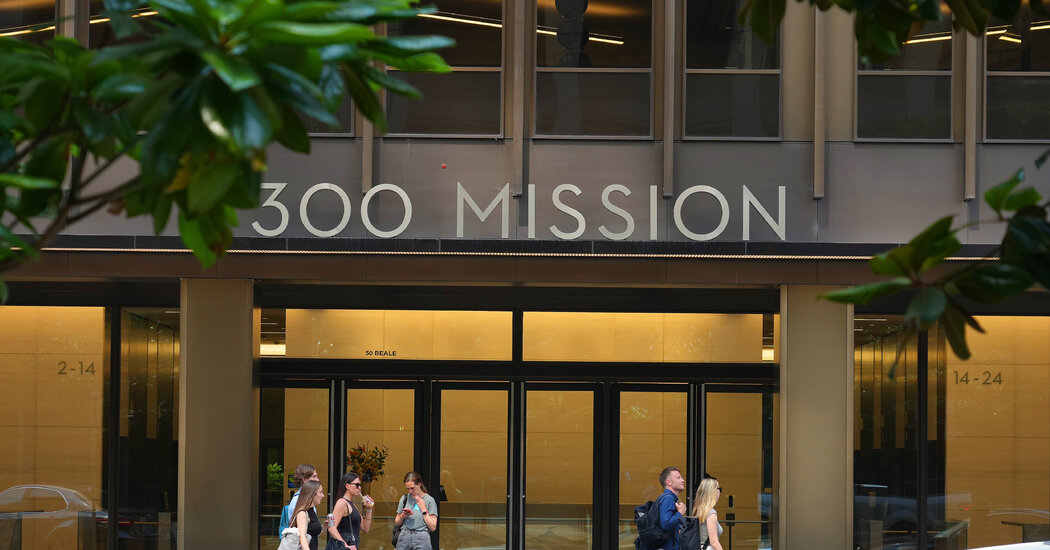Noah Horowitz, Art Basel’s New Chief, Is All About the Brand
The international art trade, like most global luxury businesses, has its dominant brands. One of the largest is the Swiss-based Art Basel, which organizes fairs for modern and contemporary art from hundreds of the world’s top dealers, in Hong Kong, Basel, Paris and Miami Beach, in each year’s four seasons.
The V.I.P. preview of Art Basel’s mother-ship event in Switzerland opens on Tuesday. Dealers traditionally keep their most desirable pieces aside for Basel, whether they are priced in the thousands or the tens of millions. With booths for 284 gallerists from 36 countries in a vast exhibition center with a circular courtyard, plus an adjoining hangar for dealers to offer oversize works, the format feels reassuringly familiar.
But guided by James Murdoch, whose Lupa Systems venture capital firm has been the “anchor” investor in the organizer’s Swiss parent company, MCH, since 2020, and the fairs’ new chief executive, Noah Horowitz, Art Basel is quietly tweaking its business model.
“There are some changes and trends that are in place,” said Horowitz, 43, in a recent video interview. “We are also open-minded about how culture is changing,” he added.
“People are ever more driven by experience, and people are ever more driven by brand,” said Horowitz. “They buy at a major auction house, but they also buy from Art Basel galleries because we’re a brand.”
Horowitz’s appointment, announced in October, came as a surprise. He replaces the formidable Marc Spiegler, who oversaw the growth of the fair brand for 15 years and was widely regarded as one of the art world’s most influential figures. Horowitz returned to Art Basel from Sotheby’s, where he had a 13-month spell as the head of gallery and private dealer services; before that, he spent six years as Art Basel’s director of the Americas, in charge of the Miami Beach fair.
“When I left Art Basel two years ago, one of the difficult things was not knowing what impact James and his partners would have as stakeholders,” said Horowitz.
Murdoch, 50, discussing his vision for Art Basel in a rare podcast interview earlier this month, expressed admiration for Formula 1’s “traveling circus” business model of Grands Prix around the world that “convene a broader community.” Though Murdoch said he wasn’t sure how many big fairs the art market could sustain, he added that Art Basel is one of those brands that “are bigger than their business, and are an opportunity for growth.”
At a time when economic headwinds are blowing across the art world and many fear a market correction, consolidation rather than expansion appears to be Art Basel’s priority. In January, MCH group announced that it would no longer be holding its Masterpiece fair in London at the end of June, citing rising costs and a decline in international exhibitors.
In East Asia, a prime growth region for the international art market, MCH has recently developed relationships with boutique events, making a measured investment in the Art SG fair, in Singapore, and offering consulting services to S.E.A. Focus and Art Week Tokyo. Industry observers viewed these moves as MCH’s hedging against trading conditions deteriorating in Hong Kong, where so many of the West’s leading auction houses and galleries have established branches, and where Art Basel runs a fair. Last year, Art Basel’s main rival, Frieze, owned by the California-based entertainment group Endeavor, opened a branded fair in Seoul.
But, for now, Hong Kong continues to be Asia’s power art market hub. The latest March edition of Art Basel Hong Kong, the first to be held after China’s protracted coronavirus lockdown restrictions were lifted, drew 86,000 visitors, just 2,000 down from the event’s 2019 attendance.
“That week set down a marker for the centrality of Hong Kong in the Asian market,” said Horowitz. As for Art Basel’s other investments in East Asia, these were about “recognizing the size and scale of the Asian market” and “supporting galleries in the ecosystem that sustains them,” he added.
Art Basel’s four own-brand fairs remain his central priority, Horowitz added. There could be no expansion without these events “thriving and remaining best in class,” he said.
To ensure that, Horowitz has overseen the introduction of a new management structure for Art Basel’s more than 120 full-time staff. Below Horowitz, Vincenzo de Bellis, a former curator at the Walker Art Center in Minneapolis, oversees the management of all four fairs, each of which now has its own dedicated director. In May, Maike Cruse, the respected former director of Gallery Weekend Berlin, was appointed to lead the Swiss fair.
Yet beyond the realm of corporate restructuring, and the corporate language that goes with it, Horowitz, like Murdoch in his podcast and Spiegler before them, has a vision of Art Basel as an experience that is more than just an art fair. Art Basel should use “brand activation” to engage other “cultural classes” such as fashion, film, music and design, and with “audiences at the periphery of what we do, potentially to create new realities,” said Horowitz.
But how can Art Basel engage with audiences on the periphery of the art world if it charges 67 Swiss Francs, or about $74, for a standard day ticket — some three times the price of entry to the Museum of Modern Art in New York — and charges ultrawealthy V.I.P.s nothing for its preview days?
“We have a duty to deliver clients to our galleries,” Horowitz said, and a responsibility to deliver “the great collectors and institutions of the world to their booth.”
“That’s the business we’re in,” he added.
For all the talk of art fairs becoming zeitgeist-changing cultural happenings, they remain, at the bottom line, high-stakes commercial events. Participating dealers, many of whom operate multiple galleries, pay hundreds of thousands of dollars to exhibit at Art Basel’s traveling circus of fairs. “These dealers are running big businesses,” said Candace Worth, a New York-based art adviser, who, as usual, will be in Basel for the first V.I.P. day of the Swiss fair. “They need to sell a lot of art to keep these businesses afloat.”


